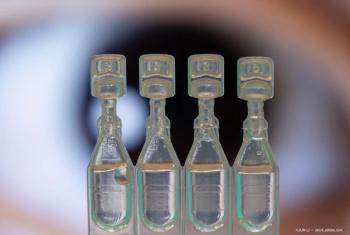
Duet-Kelman phakic IOL seems safe and efficacious 1 year after implantation
Lisbon, Portugal - The Duet-Kelman phakic lens seems to be safe and efficacious to correct moderate and high degrees of myopia, and patients with high degrees of myopia expressed satisfaction with their increased vision, according to Gonzalo Bernabeu, MD. He reported his experience with the IOL Monday at the European Society of Cataract and Refractive Surgeons meeting.
Lisbon, Portugal - The Duet-Kelman phakic lens seems to be safe and efficacious to correct moderate and high degrees of myopia, and patients with high degrees of myopia expressed satisfaction with their increased vision, according to Gonzalo Bernabeu, MD. He reported his experience with the IOL Monday at the European Society of Cataract and Refractive Surgeons meeting.
Following creation of a 2-mm incision, the lens is implanted in two stages. First, the haptic is inserted, a viscoelastic agent is injected, and the optic is injected and the IOL is assembled, Dr. Bernabeu explained. He is from the Vissum-Instituto Oftalmologico de Alicante, Alicante, Spain.
The outcomes with the IOL were analyzed in 138 eyes of patients with myopia that ranged from –8 to –23.5 D. Dr. Bernabeu reported that there is adequate distance (i.e., 1,500 µm) between the optic and the endothelium. The patients had a mean increase in uncorrected visual acuity increase of 2.5 lines of vision, which resulted in high degrees of patient satisfaction. The rate of endothelial cell loss was an acceptable 7.16%. Initially, patients had significant increases in IOP, which then stabilized about 3 months after IOL implantation. Complications associated with this lens were haptics that were too long or too short (4%), pupil ovalization (4%), and ectopic pupils (3%).
“There are considerations when implanting this lens, specifically: patient age, the depth of the anterior chamber, the angle shape, the degree of refractive error, recovery of vision, the quality of vision, and future complications,” Dr. Bernabeu said.
“This lens is safe and effective to treat high levels of myopia. The results of the first year of follow-up are satisfactory,” he concluded.
Newsletter
Don’t miss out—get Ophthalmology Times updates on the latest clinical advancements and expert interviews, straight to your inbox.














































.png)


